winter tires AUDI A6 2017 Owners Manual
[x] Cancel search | Manufacturer: AUDI, Model Year: 2017, Model line: A6, Model: AUDI A6 2017Pages: 280, PDF Size: 70.24 MB
Page 70 of 280
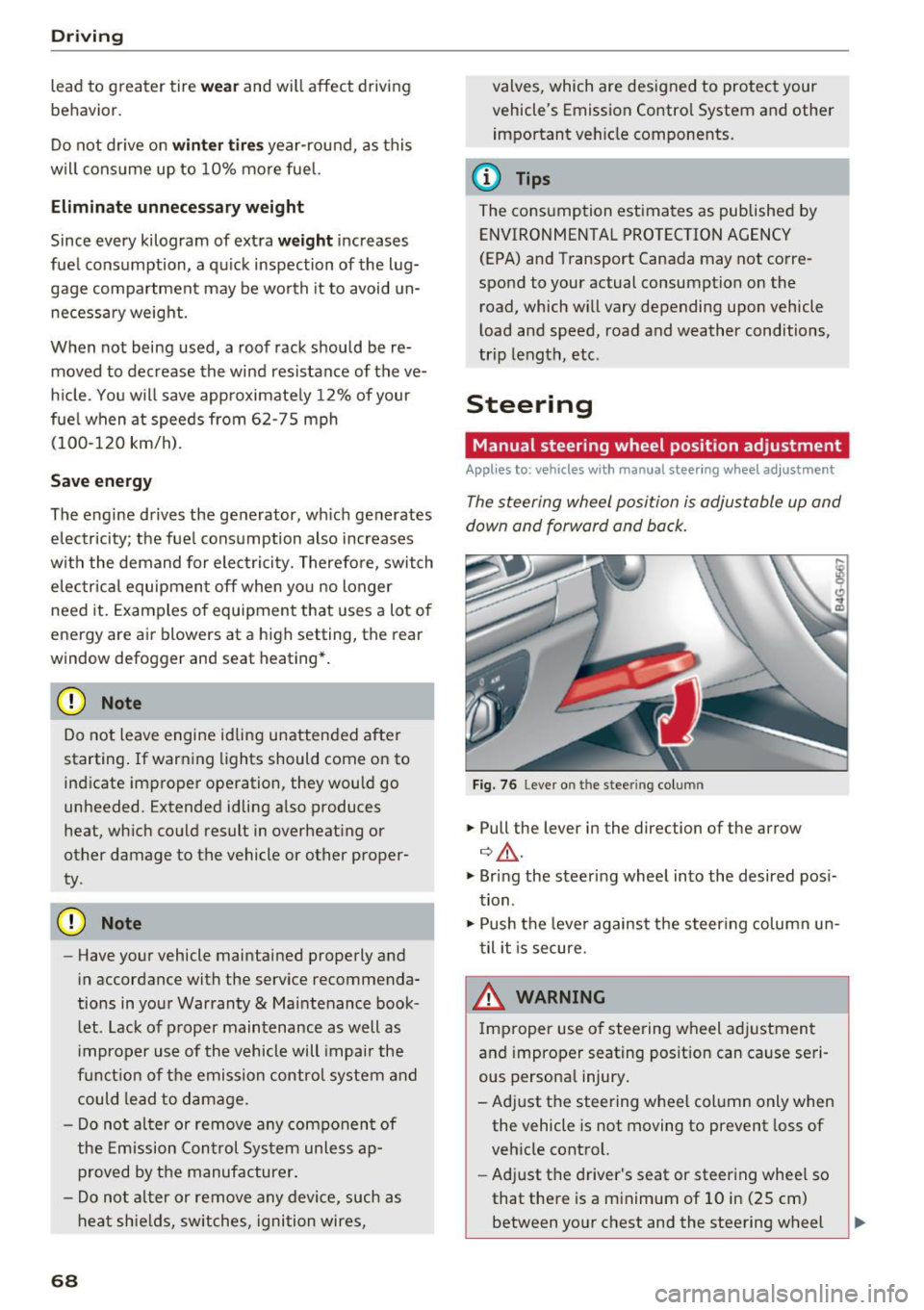
Driving
lead to greater tire wear and will affect driving
behavior.
Do not drive on
winter tires year-round, as this
will consume up to 10% more fuel.
Eliminate unnecessary weight
Since every kilogram of extra
weight increases
fuel consumption, a quick inspection of the lug
gage compartment may be worth it to avoid un
necessary weight.
When not being used, a roof rack should be re moved to decrease the wind resistance of the ve
hicle. You will save approximately 12% of your
fuel when at speeds from 62- 7 5 mph (100-120 km/h) .
Save energy
The engine drives the generator, which generates
electricity; the fuel consumption also increases
with the demand for electricity. Therefore, switch electrical equipment off when you no longer
need it. Examples of equipment that uses a lot of
energy are air blowers at a high setting, the rear
window defogger and seat heating*.
CD Note
Do not leave engine idling unattended after
starting.
If warning lights should come on to
indicate improper operation, they would go
unheeded. Extended idling also produces
heat, which could result in overheating or
other damage to the vehicle or other proper
ty .
CD Note
- Have your vehicle maintained properly and
in accordance with the service recommenda
tions in your Warranty
& Maintenance book
let . Lack of proper maintenance as well as
improper use of the vehicle will impair the
function of the emission control system and
could lead to damage.
- Do not alter or
remove any component of
the Emission Control System unless ap
proved by the manufacturer.
- Do not alter or remove any device, such as
heat shields, switches, ignition wires,
68
valves, which are designed to protect your
vehicle's Emission Control System and other
important vehicle components.
(D Tips
The consumption estimates as published by
ENVIRONMENTAL PROTECTION AGENCY
(EPA) and Transport Canada may not corre
spond to your actual consumption on the
road, which will vary depending upon vehicle
load and speed, road and weather conditions,
trip length, etc.
Steering
Manual steering wheel position adjustment
Applies to: vehicles with manual steering wheel adjustment
The steering wheel position is adjustable up and
down and forward and back.
Fig. 76 Lever o n the stee ring col umn
.,. Pull the lever in the direction of the arrow
¢ ,&. .
.,. Bring the steering wheel into the desired posi
tion .
.,. Push the lever against the steering column un
til it is secure.
& WARNING
Improper use of steering wheel adjustment
and improper seating position can cause seri
ous personal injury.
- Adjust the steering wheel column only when the vehicle is not moving to prevent loss of
vehicle control.
- Adjust the driver's seat or steering wheel so
that there is a minimum of 10 in (25 cm)
between your chest and the steering wheel -
Page 88 of 280
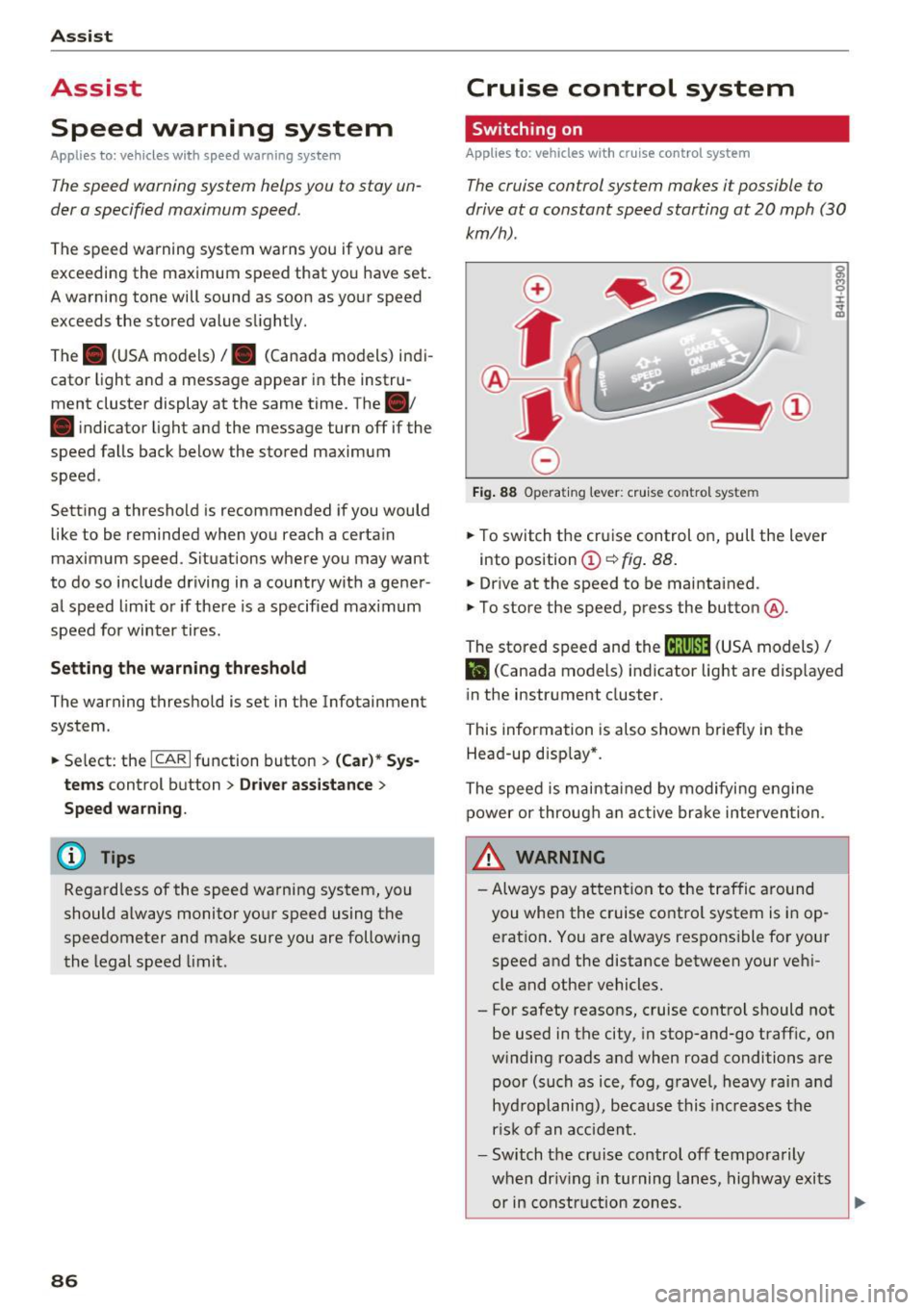
Assist
Assist Speed warning system
Applies to: vehicles with speed warning system
The speed warning system helps you to stay un
der a specified maximum speed.
The speed warning system warns you if you are
exceeding the maximum speed that you have set.
A warning tone will sound as soon as your speed
exceeds the stored value slightly.
The . (USA models)/ . (Canada models) indi
cator light and a message appear in the instru
ment cluster display at the same time. The •
• indicator light and the message turn off if the
speed falls back below the stored maximum
speed .
Setting a threshold is recommended if you would
like to be reminded when you reach a certain
maximum speed. Situations where you may want
to do so include driving in a country with a gener
al speed limit or if there is a specified maximum
speed for winter tires.
Setting the warning threshold
The warning threshold is set in the Infotainment
system.
.. Select: the
ICARI function button > (Car)* Sys
tems
control button > Driver assistance >
Speed warning.
(D Tips
Regardless of the speed warning system, you
should always monitor your speed using the
speedometer and make sure you are following
the legal speed limit.
86
Cruise control system
Switching on
Applies to: vehicles with cruise control system
The cruise control system makes it possible to
drive at a constant speed starting at 20 mph (30
km/h) .
0
f
~
0
Fig. 88 Operat ing lever: cruise co ntro l syste m
.,. To switch the cruise control on, pull the lever
into posit ion
(D ~ fig . 88.
.,. Drive at the speed to be maintained .
.,. To store the speed, press the button @.
~ M 0 :i:
;;i;
The stored speed and the (ij;\1)~14 (USA models) /
l'I (Canada models) indicator light are disp layed
in the instrument cluster.
This information is also shown briefly in the
Head-up disp lay* .
The speed is maintained by modifying engine
power or through an active brake intervention.
~ WARNING
-Always pay attention to the traffic around
you when the cruise control system is in op
eration . You are always responsible for your
speed and the distance between your vehi
cle and other vehicles.
- For safety reasons, cruise control should not be used in the city, in stop-and-go traffic, on
winding roads and when road conditions are poor (such as ice, fog, gravel, heavy rain and
hydroplaning), because this increases the
r isk of an accident.
- Switch the cruise control off temporarily
when dr iv in g in turning lanes, highway exits
or in construction zones.
-
Page 126 of 280
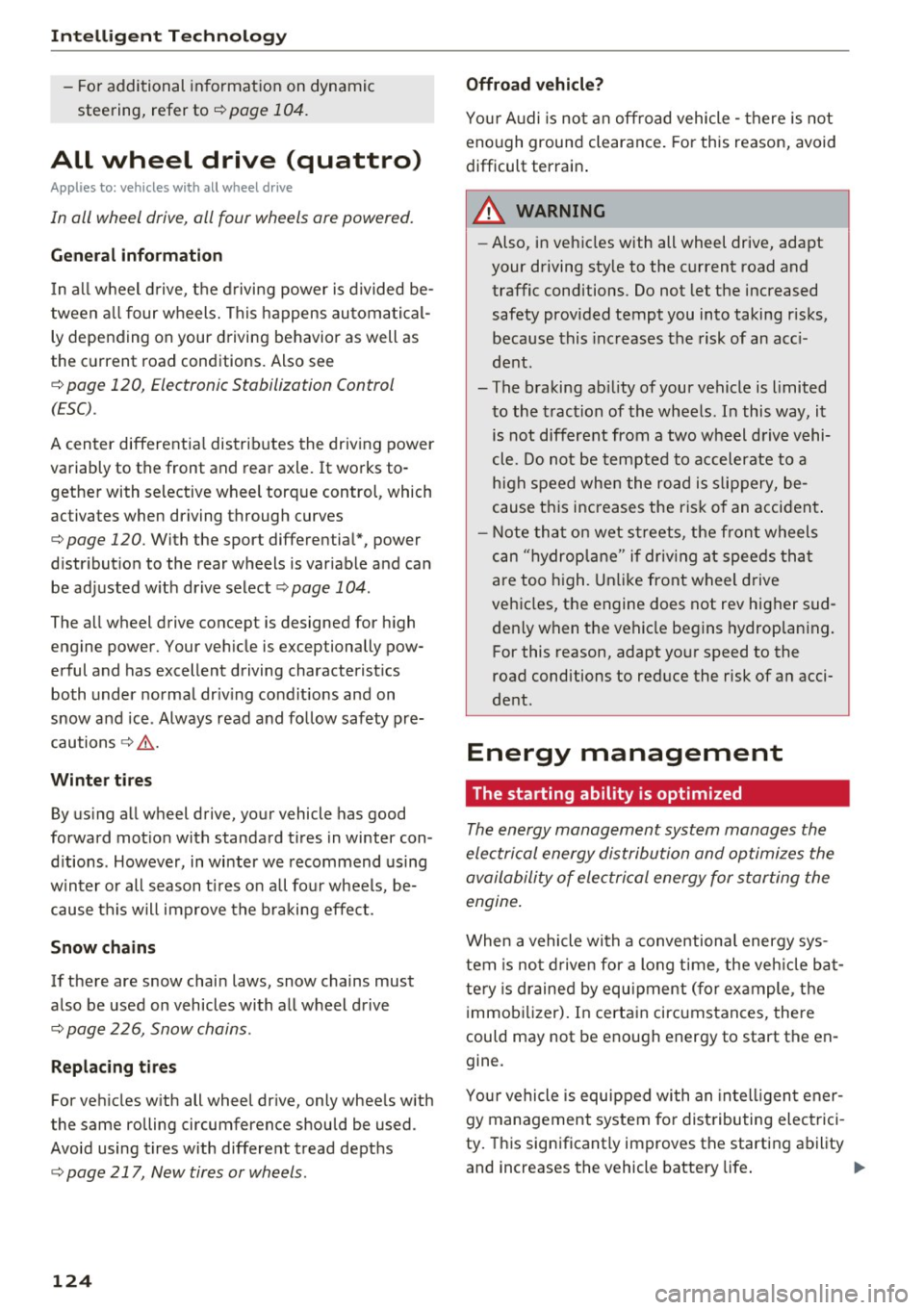
Intelligent Technology
- For addi tional in format ion on dynamic
steering, refer to
c:> page 104.
ALL wheel drive (quattro)
Applies to: vehicles with all wheel drive
In oil wheel drive, all four wheels ore powered.
General information
In a ll wheel d rive, the d rivi ng power is divided be
t ween a ll four wheels. Th is happens au tomatical
ly depending on your driving behavior as well as
the current road cond itions. Also see
c::> page 120, Electronic Stabilization Control
(ESC) .
A center differentia l distrib utes the driv ing power
variably to the front and rear axle. It works to
gethe r with selective wheel torq ue control, which
activates when driving through curves
c::> page 120. With the sport differentia l", power
d istr ibut ion to the rear wheels is variable and can
be ad justed w ith drive select
c::> page 104.
The a ll wheel drive concept is designed for h igh
engine power. Your ve hicle is exceptionally pow
erful and has excellent driving characterist ics
both under normal dr iv ing condit ions and on
snow a nd ice . Always read and fo llow safety pre
cautions
c::> ,& .
Winter tires
By us ing a ll wheel drive, your vehicle has good
forward mot io n with standard t ires in winter con
d itions . However, in winter we recommend using
w inter or all season t ires on all fo ur wheels, be
cause th is w ill improve the b raking effe ct.
Snow chains
If there are snow chain laws, snow chains must
also be used on vehicles with all wheel drive
c::> page 226, Snow chains .
Replacing tires
For vehicles w ith all wheel dr ive, only whee ls with
the same rolling circumference should be used .
Avoid using t ires with different tread depths
c::> page 217, New tires or wheels .
124 Offroad vehicle?
You
r A udi is no t an off road vehicle -there is not
eno ugh ground clearan ce . F or this reason, avoid
difficult terra in .
_&. WARNING
- Also, in veh icles with all wheel drive, adapt
your driving sty le to the current road and
traffic conditions. Do not let the increased
safety provided tempt you into taking r isks,
because this inc reases the risk of an acc i
dent .
- The b raking ab ility of your vehicle is limited
to the t raction of the whee ls . In this way, i t
is not different from a two wheel d rive vehi
cle. Do not be tempte d to accelerate to a
hig h speed when the ro ad i s slip pery, be
cause th is increases the r is k of an accident .
- Note that on wet s treets, the front wheels
c a n " hyd ropla ne" if driv ing a t spee ds tha t
are too h igh. Unlike front wheel drive
veh icles, t he engine does not rev higher sud
de nly when t he vehicle begins hydroplan ing.
For this reason, adapt yo ur speed to the
road conditions to reduce the risk of an acci
de nt.
Energy management
The starting ability is optimized
The energy management system manages the
elec trical energy distribution and optimi zes the
availability of electri cal energy for starting the
engine .
When a vehicle wi th a conventiona l energy sys
tem is no t driven for a l ong time , the veh icle ba t
te ry is d raine d by equ ipment ( fo r example, the
immo biliz er). In certa in circ umstances, there
could may not be enough energy to start the en
gine.
Yo ur vehicle is equipped with an inte lligen t ener
gy management system fo r dist ributing elec trici
ty. This significantly improves the starting ability
and increases the vehicle battery life . .,.
Page 212 of 280
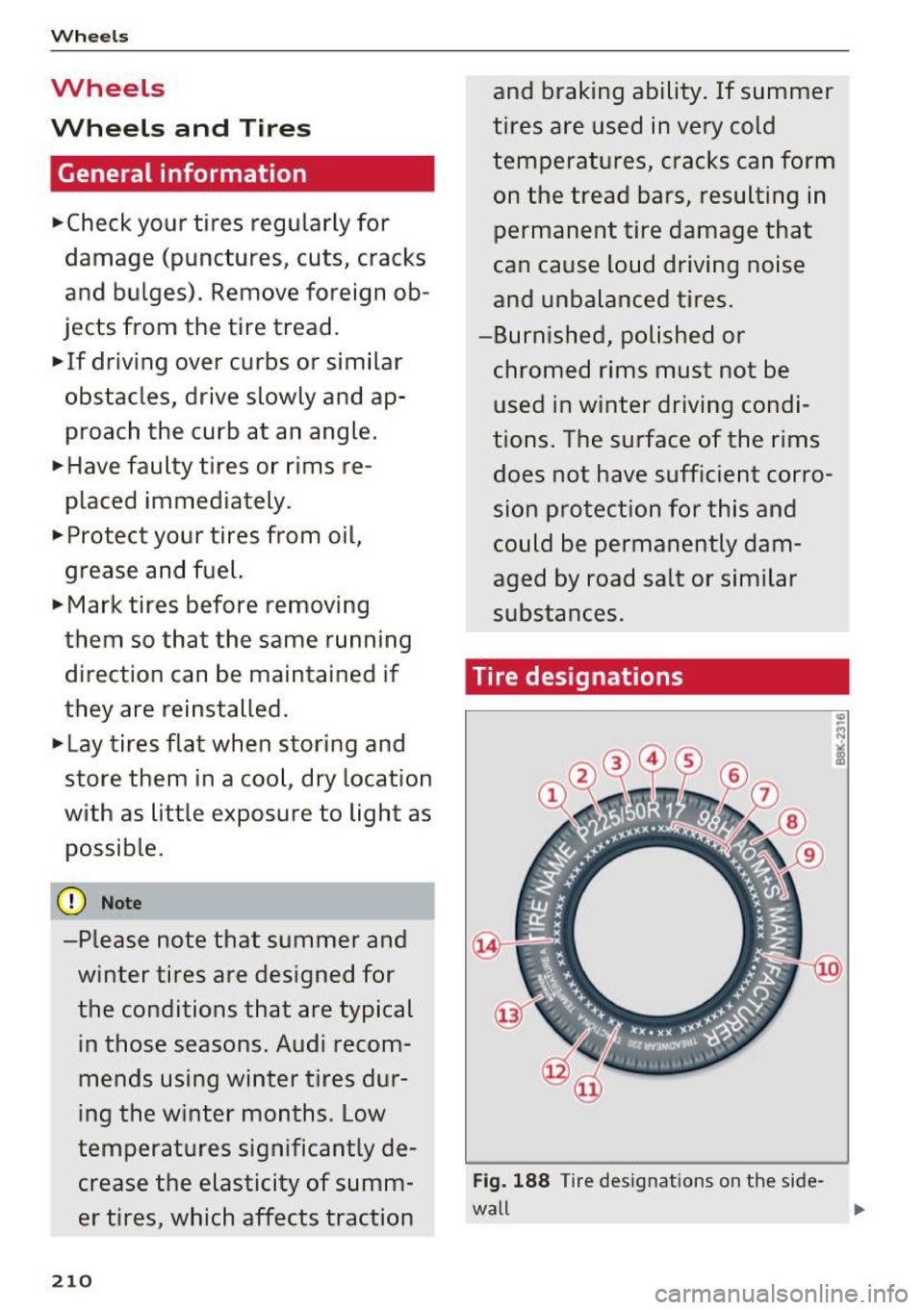
Wheels
Wheels
Wheels and Ti res
General information
.,. Check your tires regularly for
damage (punctures, cuts, cracks
and bulges). Remove foreign ob
jects from the tire tread.
.,. If driving over curbs or similar
obstacles, drive slowly and ap proach the curb at an angle.
.,.Have faulty tires or rims re
placed immediately.
.,.Protect your tires from oil,
grease and fuel.
.,.Mark tires before removing
them so that the same running
direction can be maintained if
they are reinstalled .
.,. Lay tires flat when storing and
store them in a cool, dry location
with as little exposure to light as
possible.
(D N ote
-Please note that summer and
winter tires are designed for
the conditions that are typical in those seasons . Audi recom
mends using winter tires dur
ing the winter months . Low
temperatures significantly de crease the elasticity of summ
er tires, which affects traction
2 10
and b raking ability. If summer
tires are used in very cold
temperatures, cracks can form
on the tread bars, resulting in permanent tire damage that
can cause loud driving noise
and unbalanced tires.
-Burnished, polished or chromed rims must not be used in winter driving condi
tions. The surface of the rims
does not have sufficient corro
sion protection for this and
could be permanently dam
aged by road salt or similar
substances.
Tire designations
F ig. 188 Tire des ignat ions on the side-
wall II>
Page 217 of 280

a,
a,
..... N r-. N ..... 0
s ..
Rim
means a metal support for a tire
or a tire and tube assembly upon
which the tire beads are seated.
Rim di amet er
means nominal diameter of the
bead seat. If you change your
wheel size, you will have to pur
chase new tires to match the new
rim diameter.
Rim size designation
means rim diameter and width.
Rim width
means nominal distance between
rim flanges.
Sidewall
means that portion of a tire be
tween the tread and bead.
Speed rating (letter code )
means the speed at wh ich a tire is
designed to be driven for extend
ed periods of time . The ratings
range from 93 mph (150 km/h)
to 186 mph (298 km/h)
¢ table
on page 211.
You may not find
this information on all tires be
cause it is not required by law.
The speed rating letter code,
where applicable, is molded on
the tire sidewall and indicates the
Wheels
maximum permissible road
speeds
¢ A in Winter tires on
page 225.
T ire pressure mon itoring
system *
means a system that detects
when one or more of a vehicle's
tires are underinflated and illumi
nates a low tire pressure warning
telltale.
T read
means that portion of a tire that
comes into contact with the road .
Tread separation
means pulling away of the tread
from the tire carcass.
Treadwear indicators (TWI )
means the projections within the
principal grooves designed to give
a visual indication of the degrees
of wear of the tread. See
¢ page 219, Treadwear indicator
for more information on measur
ing tire wear .
Uniform Tire Quality Grading
is a tire information system devel
oped by the United States Nation
a l Highway Traffic Safety Admin
istration (NHTSA) that is designed
to help buyers make relative
215
..
Page 219 of 280
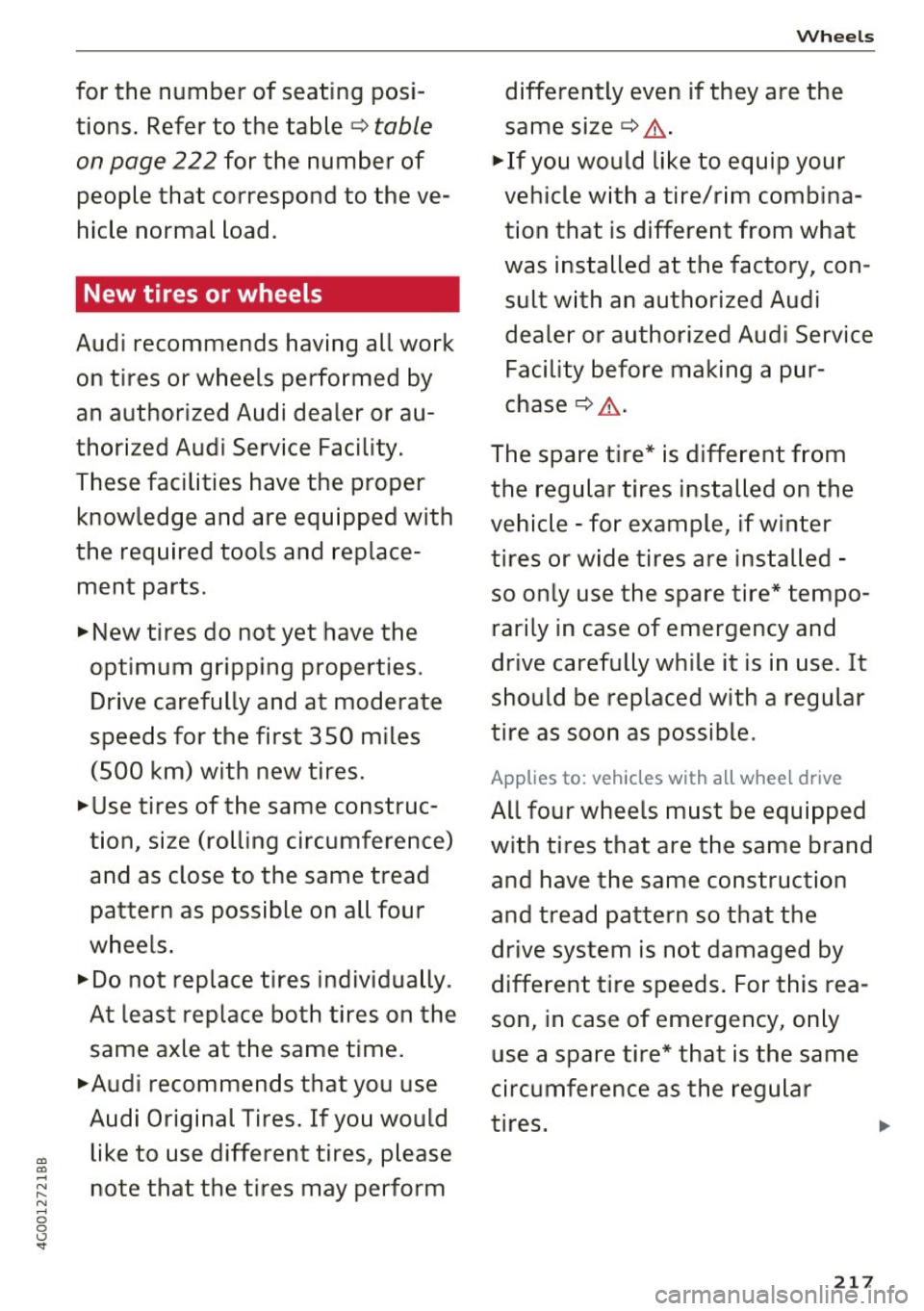
a,
a,
..... N ,.__ N ..... 0
s ..
for the number of seating posi
tions. Refer to the table ¢
table
on page 222
for the number of
people that correspond to the ve
hicle normal load.
New tires or wheels
Audi recommends having all work on tires or wheels performed by
an author ized Audi dealer or au
thorized Audi Service Facility.
These facilities have the proper
knowledge and are equipped with
the required tools and replace
ment parts.
.,.New tires do not yet have the
optimum gripping properties. Drive carefully and at moderate
speeds for the first 350 miles
(500 km) with new tires.
.,.Use tires of the same construc
tion, size (rolling circumference)
and as close to the same tread
pattern as possible on all four
wheels.
.,.Do not replace tires individually .
At least replace both tires on the
same axle at the same time.
.,.Audi recommends that you use
Audi Original Tires. If you would
like to use different tires, please
note that the tires may perform
Wheels
differently even if they are the
same size¢.&,. .
.,. If you would like to equip your
vehicle with a tire/rim combina
tion that is different from what
was installed at the factory, con
sult with an authorized Audi
dealer or authorized Audi Service
Facility before making a pur
chase¢ .&,..
The spare tire* is different from
the regular tires installed on the
vehicle -for example, if winter
tires or wide tires are installed -
so only use the spare tire* tempo
rarily in case of emergency and
drive carefully while it is in use . It
should be replaced with a regular
tire as soon as possible.
Applies to: vehicles with all whee l dr ive
All four wheels must be equipped
with tires that are the same brand
and have the same construction
and tread pattern so that the drive system is not damaged by
different tire speeds. For this rea
son, in case of emergency, only
use a spare tire* that is the same
circumference as the regular
tires. ,..
217
Page 227 of 280
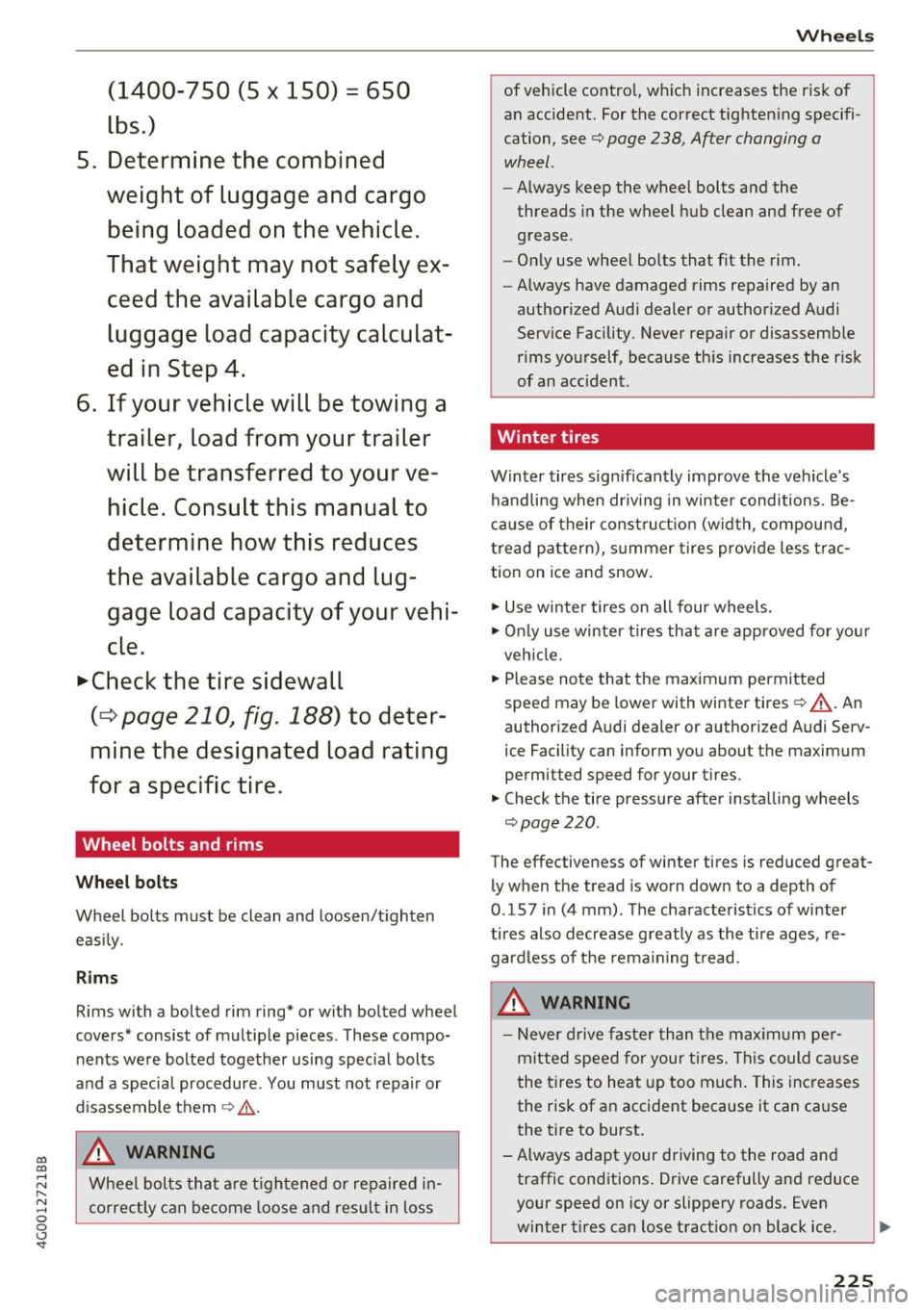
co
co
,...,
N
" N ,...,
0 0 <..:l -
lbs.)
5 . De termin e the combined
w eig ht of lugg age and carg o
b eing load ed on the vehicle .
Th at w eight ma y not safel y ex
c e e d th e ava ilabl e c argo and
lu ggag e load ca pacit y ca lculat
ed in Step 4 .
6 . I f you r veh ic le will b e tow ing a
tr aile r, load from your tr ailer
will be tran sferred to y our
ve
hi cle . Con sult thi s manual to
de te rmin e how this redu ces
th e av ailabl e car go and lug
ga ge load capa cit y o f your vehi
cle.
..,. Chec k the tire s idewall
(¢pag e 210, fig . 188) to de ter
min e the de sign ated load r ating
for a speci fic tire.
Wheel bolts and rims
Wheel bolts
Wheel bolts must be clean and loosen/t ighten
eas ily.
Rims
Rims with a bolted rim ring " or with bolted wheel
covers* consist of multip le pieces . These compo
n ents were bolted together using specia l bolts
a nd a special procedure . You must not repair or
d isassemble th em ¢.&. .
_& WARNING
Wheel bolts tha t are t igh tened or re paired in
c orrectly can be come loose and result in loss
Wh eel s
of vehicle contro l, wh ich increases the risk of
an accident. For the cor rect tighten ing spec ifi
cation, see
c:> page 238, After changing a
wheel .
-Always keep the wheel bolts and the
threads in the wheel hub clean and free of
grease .
- Only use wheel bolts that fit the rim.
- Always have damaged rims repaired by an
authorized Audi dealer or author ized Audi
Serv ice Facility. Never repair o r disassemb le
rims you rself, because th is increases the r isk
of an acc ident .
Winter tires
Winter tires signif icant ly imp rove the vehicle's
handling when dr iv ing in winter conditions. Be
ca use of their const ru ct io n (w idth, compou nd,
t read pat tern), summer tires provide less t rac
tion on ice and snow .
.,. Use winter tires on all four wheels.
.,. Onl y use winter tires that a re approved fo r yo ur
veh icle .
.,. Please note that the maximum permitted
speed may be lower with winter tires
c:> _&. . An
author ized Audi dealer or authorized A udi Serv
ice Facility can inform you about the maximum
permit ted speed for your tires.
.,. Check the tire pressure after insta lling wheels
c=> page220 .
The effectiveness of winter tires is reduced great
ly when the tread is worn down to a depth of
0.157 in (4 mm) . T he characterist ics of winter
t ir es also decrease g reatly as the tire ages, re
gardless of t he rema in ing t read.
_& WARNING
- Never drive fas ter than the max imum pe r
mitted speed for your tires. This could c ause
the t ires to heat up too much. This increases
the risk of an accident because it can cause
the t ire to burst.
- Always adapt your driving to the road and traffic conditions. Drive carefully and reduce
your speed on icy or slippery roads . Even
winter t ires can lose tract ion on black ice . ..,..
225
Page 229 of 280

co
co
.... N
" N .... 0
In o rder to minimize the oc currence of impact
damage to the tires of your vehicle, we recom mend that you observe the fo llow ing
precautions:
- Always maintain recommended inflation pres
sures. Check your tire pressure every 2,000
miles (3,000 km) and add a ir if necessary .
- Drive carefully on roads with potho les, deep
gullies or ridges. The impact from driving
through or over such obstacles can damage
your tires . Impact w ith a curb may also cause
damage to your tires.
- After any impact, immediately inspect your
tires or have them inspected by the nearest au
thorized Aud i dealer . Replace a damaged tire as
soon as poss ible .
- Inspect your t ires every 2 ,000 miles (3,000 km)
for damage and wear . Damage is not always
easy to see . Damage can lead to loss of a ir and
underinflation , which cou ld eventually cause
t ir e failure. If you be lieve tha t a tire may have
been damaged, replace the t ire as soon as pos
s ible.
= T hese tires may wear more q uick ly than othe rs.
- Please a lso remember that, while these tires
deliver responsive hand ling, they may r ide less
comfortab ly and ma ke more no ise th an other
cho ices .
Reduced performance in winter /cold season
condit ions
All t ires are desig ned fo r ce rtain pur poses. The
l ow aspect ratio, ul tra high performance t ires
originally insta lled on you r vehicle a re intended
for maximum dry and wet road performance and handling. They are not s uitable for cold, snowy or
icy weather cond it ions. If you dr ive under those
circumstances, you shou ld equ ip your ve hicle
with a ll-season or winter tires, wh ic h offer better
traction under those condit ions . We suggest you
use the recommended snow or all-season tires
specified fo r you r vehicle , or the ir equivalent.
Refer to¢
page 225 for more detailed informa
tion rega rding winter tires .
Uniform tire quality grading
8 -Tread wea r '
-Traction AA ABC
- Tempe ra tu re ABC
Quali ty g rades can be found where applicable o n
the tire side wall be tween tread shoulder and
max imum sec tion width
¢ page 210, fig . 188.
For example: Tread wear 200 , Traction AA, Tem
perature
A .
All passenger car ti res must conform to Federal
Safety Requiremen ts in addit io n to these grades .
Tread wear
The tread wear grade is a comparative rating
based on the wea r rate of the tire when tested
u nder controlled cond it ions on a specif ied gov
ernment test course.
F or example , a tire graded 1 50 wou ld wear one
and one half (1 1/2) times as we ll on the govern
ment course as a t ire graded 100 .
T he re lative performance of tires depends upon
t h e actual conditions of thei r use, however, and
may depa rt sig nificantly from the norm due to
variations in driv ing habits , service practices and
differences in road character istics and cli mate.
Traction
The traction grades, from highest to lowest, a re
AA , A, Band
C. Those grades represent t he tire 's
ability to stop o n we t pavement as measured un
der controlled cond itions on specified govern
ment test surfaces of asphalt and concrete. A tire
marked C may have poor traction performance
¢ ,&. .
Temperature
The temperature grades are A (the highest), B,
and C, representing the tire's resistance to the
generat ion of heat and its abi lity to dissipate
heat when tested u nder cont rolled conditions on
a specified indoor laboratory test wheel.
Sustained h igh temperatu re can cause the mate
rial of the tire to degenerate and reduce tire life,
and excessive tempe rature can lead to s udden
t ire failure ¢,&. . .,.
227
Page 231 of 280
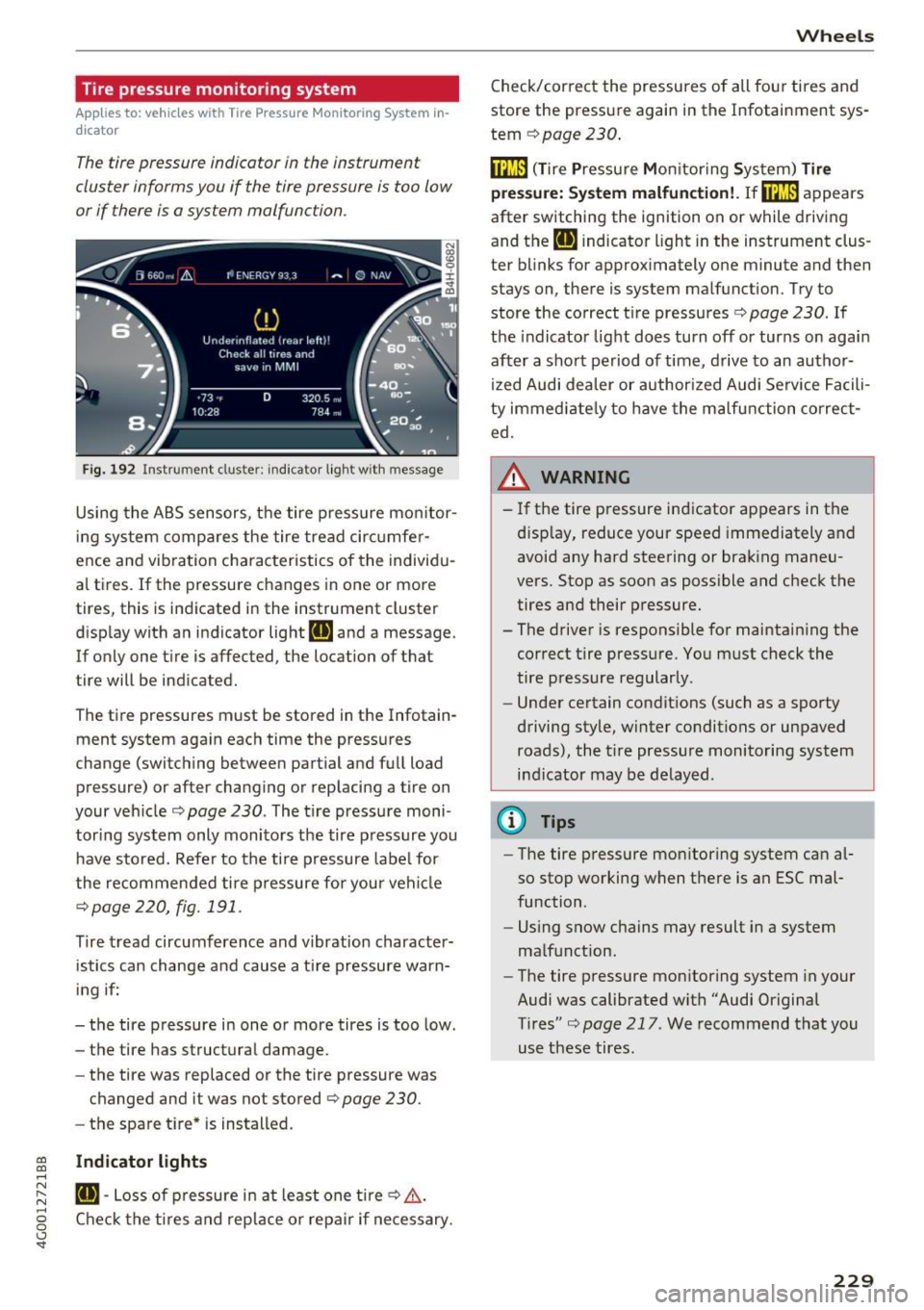
Tire pressure monitoring system
Applies to: vehicles with Tire Pressure Monitoring System in
dicator
The tire pressure indicator in the instrument
cluster informs you if the tire pressure is too low
or if there is a system malfunction .
Fig. 192 Instrument clus ter : indicator ligh t w ith message
Using the ABS sensors, the tire pressure monitor
ing system compares the tire tread circumfer
ence and vib ration characteristics of the individu
al tires.
If the pressure changes in one or more
tires, this is indicated in the instrument cluster
display with an indicator light
RE and a message.
If only one tire is affected, the location of that
tire will be indicated.
The tire pressures must be stored in the Infotain
ment system again each time the pressures
change (switching between partial and full load pressure) or after changing or replacing a tire on
your vehicle ¢
page 230 . The tire pressure moni
toring system only monitors the tire pressure you have stored. Refer to the tire pressure label for
the recommended tire pressure for your vehicle
¢page 220, fig.191 .
Tire tread circumference and v ibration character
istics can change and cause a tire pressure warn
ing if:
- the tire pressure in one or more tires is too low.
- the tire has structural damage.
- the tire was replaced or the tire pressure was
changed and it was not stored
¢ page 230.
- the spare tire* is installed.
~ Indicator lights ....
~ RE-Loss of pressure in at least one tire¢,&,. . ....
g Check the tires and replace or repair if necessary.
<.,;) 'SI"
Wheels
Check/correct the pressures of all four tires and
store the pressure again in the Infotainment sys
tem
¢ page 230 .
fflm (T ire Pressure Monitoring System) Tire
press ure: System malfunction!.
Ifffi:m appears
after switching the ignition on or while driving
and the
RE indicator light in the instrument clus
ter blinks for approximately one minute and then
stays on, there is system malfunction. Try to
store the correct tire pressures¢
page 230. If
the indicator light does turn off or turns on again
after a short period of time , drive to an author
ized Audi dealer or author ized Audi Service Facili
ty immediately to have the malfunction correct
ed.
_& WARNING ,..___
- If the tire pressure indicator appears in the
d isplay, reduce your speed immediately and
avoid any hard steering or braking maneu
vers. Stop as soon as possible and check the
tires and their pressure.
- The driver is responsible for maintaining the
correct tire pressure. You must check the
tire pressure regularly.
- Under certain conditions (such as a sporty
driving style, winter conditions or unpaved roads), the tire pressure monitoring system
indicator may be delayed .
@ Tips
-The tire pressure monitoring system can al
so stop working when there is an ESC mal
function .
- Using snow chains may result in a system
malfunction.
- The tire pressure monitoring system in your
Audi was calibrated with "Audi Original
Tires"¢
page 217 . We recommend that you
use these tires.
229
Page 245 of 280
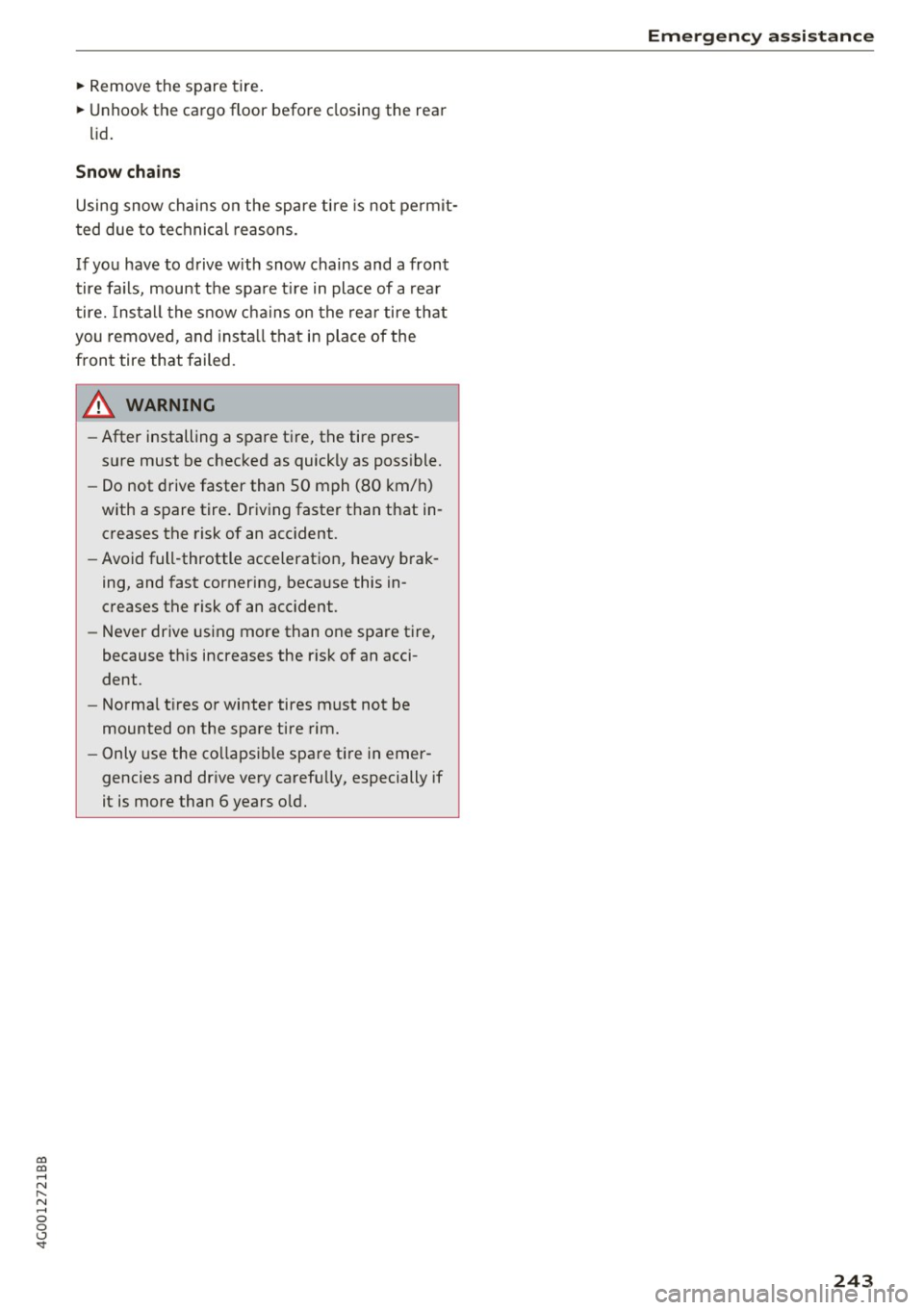
co
co
.... N
" N .... 0 0 <..:l '
~ Unhook the cargo floor before closing the rear
li d.
Snow chains
Using snow chains on the spare tire is not permit
ted due to technical reasons.
I f you have to drive with snow chains and a front
tire fa ils, mount the spa re tire in place of a rear
tire. Install the snow chains on the rear tire that
you removed , and insta ll that in place of the
front tire that failed.
A WARNING
-
-After installing a spare tire, the tire pres
sure must be checked as quickly as possible.
- Do not drive faster than 50 mph (80 km/h)
with a spare tire . Driving faster than that in
creases the risk of an acc ident.
- Avoid full-throttle acceleration, heavy brak
ing, and fast cornering, because this in
creases the risk of an acc ident.
- Never drive using more than one spare tire,
because this increases the r isk of an acci
dent .
- Norma l tires or winter tires must not be
mounted on the spare tire rim.
- Only use the collaps ible spare tire in emer
gencies and drive very carefully, especially if
it is more than 6 years o ld.
Emergency assistance
243